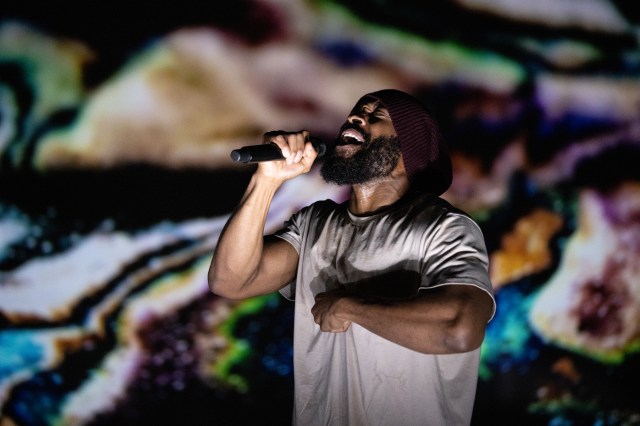Review: Arinzé Kene’s Misty Decries Gentrification in the Mouth of the Lion
Kene’s solo show, which premiered in London, is now making its New York City debut at the Shed in Hudson Yards.

(© Maria Baranova)
I couldn’t begin to talk about Misty — Arinzé Kene’s (nearly) solo show that is equal parts a harangue of gentrification and a dissection of the Black playwriting experience — without addressing the half-billion-dollar elephant in the room.
Perhaps the show felt this same ideological dissonance when it transferred from London’s Bush Theatre to the West End in 2019. But Kene now finds himself railing at overpriced coffee and the middle-class-mom-traffic he calls “pramageddon” at the Shed, a $500 million arts center smack in the middle of Hudson Yards, New York City’s biggest gentrification project in recent memory. You can take in Kene’s two-hour experimental piece about price-hiking “viruses” consuming the body of the “city creature,” and then analyze the extended metaphor over a $16 cocktail on level 2. Sarcasm aside, I’m not advocating for writing off the whole endeavor as an exercise in hypocrisy. In fact, the smell of money and “progress” that fills the Griffin Theater adds to the complicating ambiguity that comprises the most interesting core of Kene’s work.
Joining the growing canon of plays about writing plays (Michael R. Jackson’s Tony-winning musical A Strange Loop is the first that comes to mind), Misty broadly tells the story of a young Black man in London who gets in a fight on a night bus and proceeds to bear the brunt of all the city’s racist systems that keep people like him oppressed. Simultaneously, we watch Kene the artist struggle to write this story while navigating the world’s expectations of stories about Black men.
Are tales of Black trauma catnip for paying audiences who, say, frequent the Shed and are riddled with white guilt? If that’s authentically your story, must you surrender your right to tell it because of the demographic you represent? Musicians Liam Godwin and Nadine Lee double as opinionated friends Raymond and Donna who reductively call Kene’s work a “n— play,” steering him away from brooding stereotypes toward lighthearted plots that could just as easily be chastised for their entrenched minstrelsy.
I’ve grown wary of plays about the creative process and their sneaky attempts to beat critics to the punch. In the case of Misty, however, this metatheatrical portion ends up feeling more substantial than the story Kene the playwright agonizes over for two acts — a narrative that has a few poignant moments tucked between rote explanations of how real estate developers displace residents and erase cultural identity. Most of this content is delivered in spoken word poetry and music that is more atmospheric than melodic (Kene co-composes the music with Shiloh Coke) and is complemented by the creative team’s many funhouse effects that tonally reflect Kene’s diegetic indecision and a bit of his real-life indecision.
The collaboration among lighting designer Jackie Shemesh, special effects designer Jeremy Chernick, set designer Rajha Shakiry, video designer Daniel Denton, and sound designer Elena Peña delivers memorable, multisensory experiences (be warned that these often lead to sensory overload). These moments also betray the faults in Kene’s more-is-more sensibilities. Kene is an astonishingly compelling performer who wears out the stage with his physicality and takes theatrical risks with a calm conviction you would follow anywhere. He is a gift to director Omar Elerian, who can push the production to its farthest reaches without any risk of toppling off a cliff. However, illusions of artistry are not always meaningful, and Misty has yet to reliably distinguish between the two.
There are flashes of self-awareness that suggest Kene knows exactly which systems he is benefiting from at this very moment (a Shakespearean theater makes the list of gentrified establishments his central character criticizes). His onslaught of aggressive creative swings, however, innately suggests a firm and singular stance that cuts off Misty from this multi-layered conversation. Modern-day colonization of city streets is meant to parallel the colonization of artwork, and as orange balloons flood the stage (an oppressive metaphor for everything from feelings of constriction to banal entertainment to that ever-spreading virus), we are left, intentionally or not, unequivocally rooting for their decimation. If only Misty spent more time sitting in its own hot air, we’d all feel our cushy seats start to heat up.








